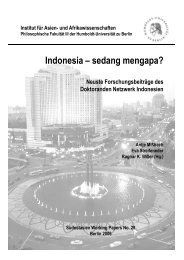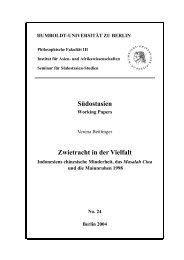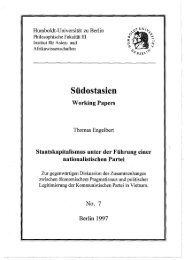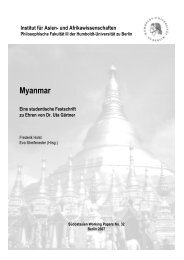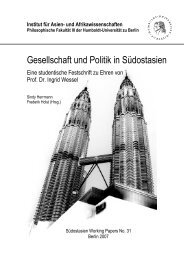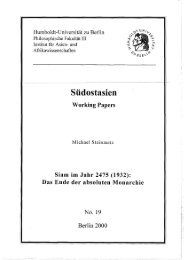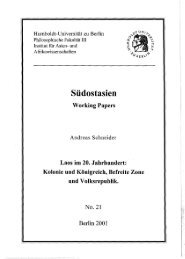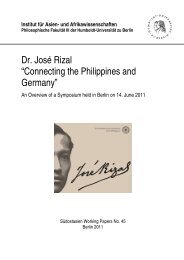On Centrism and Dualism - Humboldt-Universität zu Berlin
On Centrism and Dualism - Humboldt-Universität zu Berlin
On Centrism and Dualism - Humboldt-Universität zu Berlin
Create successful ePaper yourself
Turn your PDF publications into a flip-book with our unique Google optimized e-Paper software.
CENTRISM AND DUALISM<br />
In accordance with some of the already introduced scholars, 40 RUBEL <strong>and</strong> ROSMAN see the<br />
distinguishing feature of structuralism in the emphasis it places upon the relationship between<br />
elements, rather than upon the nature of those elements themselves, consequently contrasting<br />
structuralism from other theoretical approaches. Since these elements of structural analysis<br />
need to be identified first, they are themselves understood as constituting analytic constructs<br />
<strong>and</strong> not as given facts.<br />
Even though both authors stress relationship as the most important aspect of structure, they<br />
also emphasize that structure is nevertheless more than mere relationships. A structure<br />
constitutes a system. A relationship is merely a part of a system (ibid.: 2). The systemic nature<br />
of a structure lies in the fact that all elements are interrelated, hence a structure can only be<br />
understood when it is seen in its totality. Therefore, one of the paramount premises of<br />
structuralism is the idea of interrelated structures constituting a whole, whereby meaning is<br />
conveyed through the relation of elements between <strong>and</strong> within these structures.<br />
Structure is not reducible to a system: a group of elements <strong>and</strong> the relations that unite them. In<br />
order to be able to speak of structure, it is necessary for there to be invariant relationships between<br />
elements <strong>and</strong> relations among several sets, so that one can move from one set to another by means<br />
of a transformation (LÉVI-STRAUSS 1994: 428 [1991: 113]).<br />
While discussing the relationship of different structures, the authors identify hierarchy as the<br />
constitutive feature of these relations. The relative boundedness, found as an attribute of<br />
certain structures, can be seen as the result of hierarchy. What appears to be external to a<br />
structure on one level, making it appear bounded, reappears as being internal to the<br />
encompassing structure on a higher level (ibid.). 41<br />
Just as LÉVI-STRAUSS the two authors conceive the concept of transformation as an essential<br />
aspect of the concept of structure. They employ the concept of transformation to describe the<br />
relationship between different structures within a single society or between structures of<br />
different societies. Within a single society the authors claim that different structures st<strong>and</strong> in a<br />
homologous relationship to one another. The analyst has to illuminate the transformations<br />
which make the transition from one structure to the next possible (ibid.: 3).<br />
With their intention of comparing different societies, RUBEL <strong>and</strong> ROSMAN apply the concept<br />
of transformation in a way that resembles ERRINGTON’S. As per ERRINGTON, they link the<br />
40 RUBEL <strong>and</strong> ROSMAN claim that they draw upon the theoretical writings of LÉVI-STRAUSS, LEACH <strong>and</strong><br />
JAKOBSON.<br />
41 Here we encounter a perception of the concept of structure, which seems to resemble the core paradigm of<br />
DUMONT’S perspective, viz. the idea of encompassed distinguishable levels/structures constituting a whole.<br />
22



